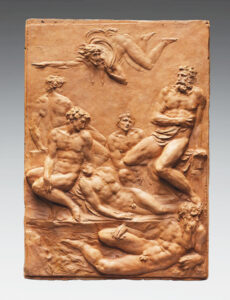 Cleveland, March 29, 2024: The Cleveland Museum of Art (CMA) announces the acquisition of a rare terracotta by Pierino da Vinci and a suite of four prints by Philipp Otto Runge, considered the crowning achievement of his career.
Cleveland, March 29, 2024: The Cleveland Museum of Art (CMA) announces the acquisition of a rare terracotta by Pierino da Vinci and a suite of four prints by Philipp Otto Runge, considered the crowning achievement of his career.
Pierino da Vinci’s terracotta relief The Death of Count Ugolino della Gherardesca and His Sons (c. 1550) depicting Canto 33 from the Inferno of Dante’s Divine Comedy is a masterpiece of the Italian High Renaissance. As the nephew of Leonardo da Vinci, Pierino was considered the heir to his uncle’s artistic genius, and he was also one of the most talented artists in 16th-century Florence in his own right. Due to his untimely death at the age of 23, his oeuvre is exceptionally small, making this an incredibly rare acquisition.
The terracotta depicts Pierino’s artistic interpretation of Ugolino’s fate as narrated in the Divine Comedy. Dante’s tale is based on the eponymous historical figure who, following a betrayal by a political rival, was imprisoned and left to starve alongside his sons, as seen in the relief. With skilled craftsmanship, Pierino sensitively captured Ugolino’s despondency and his sons’ anguish, endowing the relief with remarkable pathos. Interweaving history, literature, and art, this seminal artwork is the first object in the CMA’s collection of European painting and sculpture to feature the Divine Comedy and, according to recent scholarship, is the only sculpture attributed to Pierino in an American museum. The Death of Count Ugolino della Gherardesca and His Sons will be on display in gallery 118 later this spring.
The German Romantic painter, draftsman, and art theorist Philipp Otto Runge (1777–1810) was a leading advocate of the renewal of the arts in Germany at the turn of the 19th century. Reacting against the rationalism of neoclassicism and cultural changes such as industrialization, he searched for a new art rooted in a more personal and spiritual response to nature. Runge’s innovative approach to landscape focused on allegories of nature as the vehicle through which to understand God and the sublime on earth.
Runge’s large-scale, four-part print series Tageszeiten (Times of Day) encapsulates the artist’s artistic and philosophical ideas and is considered a monument of German Romantic printmaking. He developed the drawings obsessively over the course of two years, and then worked with three master printmakers to translate them into prints. Throughout the series, flowers carry most of the meaning, and Runge used their life cycles and blooms to evoke the cycles of birth, decay, and death, pairing them with symbols derived from an eclectic range of sources—17th-century mysticism, classical poetry, German folk traditions, and Christianity. This first state of the series was completed just five years before the artist’s death at the young age of 33.
For more information about the museum and its holdings, programs, and events, call 888-CMA-0033 or visit cma.org.

